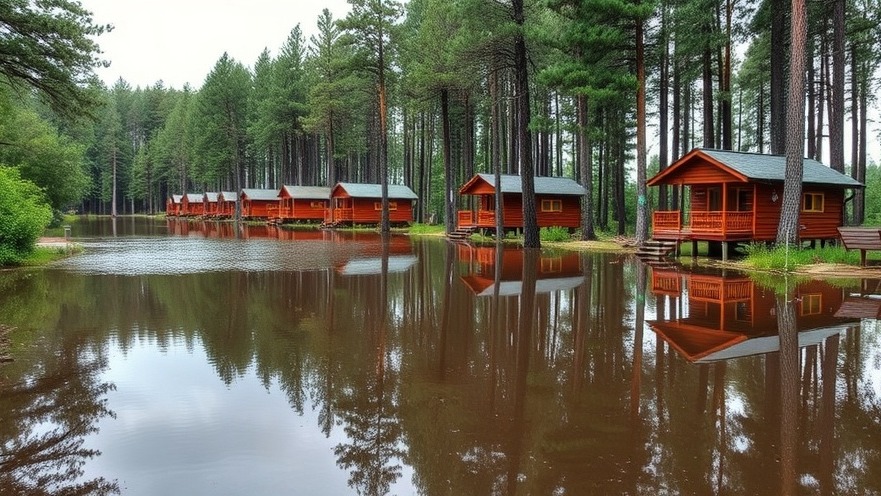
Flooding Tragedy Sparks Concerns Over Summer Camps in Texas
The recent flooding along the Guadalupe River has reignited discussions about the safety of summer camps located in flood-prone areas. Of particular note is the all-girls Christian summer camp, Camp Mystic, where 27 individuals, predominantly children, tragically lost their lives. This devastating event occurred just as journalists investigated the broader implications of flood risks for camps situated along the river, highlighting that these locations often fall within dangerous floodplain zones.
Understanding the Risk: Flood Zones and Infrastructure
Many of the affected camps were constructed several decades ago, long before contemporary flood mapping and modeling were established. According to an analysis by the Texas Tribune, 13 summer camps along the Guadalupe River are located in areas known for their vulnerability to floods. “Unfortunately, I'm not surprised,” remarked Sarah Pralle, a Syracuse University environmental policy professor, reflecting on the widespread issue of overbuilding in flood zones across the nation. The blend of nostalgia for long-standing camp traditions and the ever-present threat of flooding complicate the decisions camp owners face regarding infrastructure safety.
Outdated Flood Maps: A Growing Concern
Experts caution that flood risk assessments currently used rely on outdated data of rainfall patterns, particularly in light of climate change. The Federal Emergency Management Agency (FEMA) maps, which shape insurance rates and local regulations, fail to accurately project the increased flooding potential exacerbated by climate variations. This gap in reliable data raises alarming questions about public safety in locations filled with vulnerable youth during seasonal summer activities.
Local Impact: The Camps in the 100-Year Floodplain
Analyzing recent satellite imagery revealed that numerous camp facilities, including Camp Capers, Bear Creek Scout Camp, and Hermann Sons Life Camp, exist within flood-prone areas. To protect lives, steps must be made to mitigate this risk and ensure camper safety through infrastructure improvements and effective storm preparedness. Many camps, regrettably, have their cabins and meeting spaces situated in these hazardous zones.
Recent Incidents Highlight the Need for Change
The July flooding not only claimed lives but also exposed systemic issues regarding both the construction of camp facilities and the planning oversight that allows such building to occur in these high-risk areas. Camp leaders are now confronted with tough decisions about how to enhance safety protocols and potentially relocate vulnerable structures to mitigate future catastrophes. For example, the owners of Camp Waldemar assert that their cabins are positioned above the floodplain, enabling them to remain safe during the recent flooding. Such insights are crucial for other camps navigating similar challenges.
Calls for Legislative Action and New Guidelines
In response to the growing awareness of these flood risks, there have been calls for legislative action to revise building codes and regulations, ensuring that no future summer camps or other structures are erected in danger zones. As Texas faces an influx of flooding events, it is paramount that politicians and local governments respond proactively to protect communities, especially the children who expect safe and enjoyable experiences during their summer retreats.
Engaging with Community Perspectives
As these discussions unfold, it is essential to engage community members—parents, camp organizers, and local officials—in dialogue about safety measures. By fostering communication, communities can collaboratively devise strategies to enhance the safety of summer camps without sacrificing the essence of summer camp experiences that many have cherished for decades. Actively soliciting feedback and experiences can uncover valuable perspectives that enrich the decision-making process.
Taking the Next Steps: Practical Solutions Ahead
The devastating outcome of the recent floods around Camp Mystic serves as a clarion call for immediate action. Implementing flood preparedness training for camp staff, revising safety protocols, and building community awareness about flood safety can lead to protective changes. It is also critical to foster relationships among local governments, camp organizations, and emergency management departments to create a cooperative framework that prioritizes public safety.
Conclusion: A Call for Collective Action to Mitigate Risks
This tragic incident underscores the sobering reality of climate impacts on our treasured youth activities. In a world increasingly affected by climate change, it is our collective duty to ensure that safety comes first. By re-evaluating camp locations and infrastructure, updating flood maps, and engaging local stakeholders, we may foster an environment where children can enjoy their summer experiences safely.
 Add Element
Add Element  Add Row
Add Row 



Write A Comment